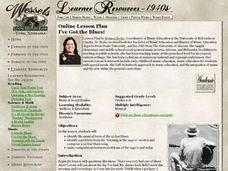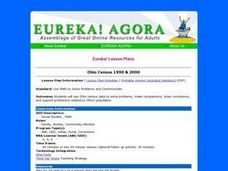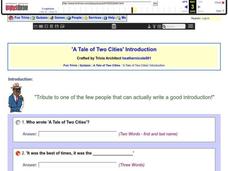Curated OER
One Size Fits All?
Students describe the differences between an estimate and a guess. They create reasonable estimates based on comparison and activities. Students explain how estimation is helpful in showing the relative size on a scale. They also...
Curated OER
Natural Born Robots: Body Builders
Students perform activities to explore how their arm works and what muscles are involved. They view animated comparisons of human and robotic arms. Students create a model of the human arm.
Curated OER
Ice Energy
Students investigate how salt affects the state of ice. In this ice cream making lesson, students change the freezing temperature by adding salt and observing the results. Students use experimentation and comparison to see how chemicals...
Willow Tree
Angles Formed by Transversals of Coplanar Lines
Create a strong understanding of the relationships formed when parallel lines intersect a transversal. Discuss each type of angle pair and their relationship to each other.
EngageNY
Solving Equations Involving Linear Transformations of the Coordinate Space
Explore methods for solving linear systems with your classes and introduce learners to using matrices as a viable method. Scholars are able to recognize situations where matrices are the efficient method of solving. Application questions...
NOAA
The Incredible Carbon Journey: Play the Carbon Journey Game
Class members explore the carbon cycle in the final installment of the 10-part Discover Your Changing World series. They play a simulation game where they walk through the steps carbon takes as it cycles through the different layers of...
Curated OER
Temperature Comparisons
Students practice plotting temperature data points on a line graph in groups and examine the temperature differences at the same time of year. They graph the temperatures in Lannon, WI, and Mitchell's Plain, SA. After the data has been...
Curated OER
A Comparison of Land and Water Temperature
Students use the NASA website's Live Access Server to create a graph of surface temperature at two locations on earth. They analyze the data and then answer specific questions provided in this lesson. They also examine and compare the...
Curated OER
I've Got the Blues!
Learners identify the musical form of the 12-bar blues. They identify a problem from the "Farming in the 1940's" section and compose a 12-bar blues song. make comparisons between problems of the 1940's and today.
Curated OER
What Is Your Angle?
Students explore the concept of angles by interacting with numerous types of measurements. They create index cards with different angles. Then they pass the cards around to other students for comparison and measurement. They practice the...
Curated OER
Introducing Temperature Measurement
Students explore temperature and use Celcius thermometers to measure and graph the temperature in the classroom daily. They estimate what they think the temperature might be and then find the actual temperature in the room.
Curated OER
The Chromosome Connection
Learners evaluate the degree of chromosome similarity and difference between humans and apes. Students infer about the relationship between a human and ape based on similarities found.
Curated OER
Ohio Census 1990 & 2000
Students use Ohio census data to solve problems, make comparisons, draw conclusions, and support predictions related to Ohio's population. They interpret and work with pictures, numbers and symbolic information.
Curated OER
Pay Check Advance Loans
Students explore the implications of obtaining loans. They assess interest rates, amount to be paid back, and the implications if they do not pay back the loan on time. Students develop a comparison chart.
Curated OER
Defining Moments
Students determine key factors in lives of individuals studied. They compare the individuals' lives using a matrix and time line, compare and contrast the lives of two individuals involved in a single historic event, and create and...
Curated OER
A Tale of Two Cities Quiz
A Tale of Two Cities begins with one of literature's most memorable paragraphs; see if you can complete it, sentence by sentence, in this quiz! Most questions are fill-in-the-blank, but the juxtaposition makes this easier.
Worksheet Web
Suffixes
Add additional meanings to root words! Scholars show what they know about suffixes and root words with a activity that challenges them to create words and complete sentences.
Curated OER
The Comet Encke Tail Disruption Event
In this comet tail disruption worksheet, students solve 7 problems using two images from NASA's STEREO satellite showing the breakup of the comet's tail. Students analyze the diagram and use the scale to solve the problems about time,...
Curated OER
Snow Day
It's a snow day, and two brothers attending schools with different schedules each got a late start to the day. But who had the shorter school day? That's what your class will find out as they apply their knowledge of fractions to this...
Howard Hughes Medical Institute
Using DNA to Explore Lizard Phylogeny
In a fun and interactive two-day lesson, learners sort anole lizard pictures by appearance. Next, they watch a video about the anoles and re-sort based on the information in the video. In addition to physical characteristics, budding...
Curated OER
Cold War Conflict in Vietnam: The Vietnam-Era Presidency
Comparing and evaluating various media types is a great way to build critical analysis skills. Learners read about the Vietnam era presidency, specifically the foreign policy established by Johnson and Nixon. Then they compare several...
National Park Service
Hibernation-Migration-Fascination
What's the difference between hibernation and a good nap? Find out with an engaging life science activity that compares the hibernation habits of grizzly bears and marmots. After learners read an informational passage about each mammal,...
Inside Mathematics
Expressions
Strive to think outside of the quadrilateral parallelogram. Worksheet includes two problems applying prior knowledge of area and perimeter to parallelograms and trapezoids. The focus is on finding and utilizing the proper formula and...
Noyce Foundation
Parallelogram
Parallelograms are pairs of triangles all the way around. Pupils measure to determine the area and perimeter of a parallelogram. They then find the area of the tirangles formed by drawing a diagonal of the parallelogram and compare their...

























